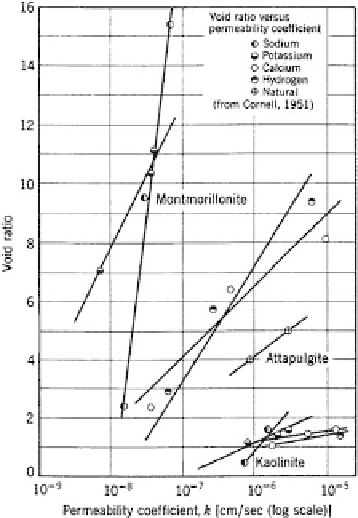Environmental Engineering Reference
In-Depth Information
Figure 6.52.
Effect of void ratio and clay mineralogy on permeability (Lambe and Whitman, 1981).
Reprinted by permission of John Wiley and Sons Inc.
Degree of saturation.
When a soil becomes partially saturated, the permeability is reduced.
This occurs due to a reduction in the total cross section of pores filled with water and surface
tension effects. These water filled pores tend to be the finer pores, because water is most read-
ily removed from the larger pores which have low suction potential. The remaining finer water
filled pores have naturally lower permeability. The partially saturated permeability may be an
order of magnitude lower than the saturated permeability. Jackson et al. (1965), Gillham et al.
(1976), Richards (1974) and Hillel (1979) discuss the relationship between saturated and
unsaturated permeability for granular and cohesive soils.
Soil fabric.
The fabric of a soil can have a major effect on the permeability. This is par-
ticularly important for soil masses in-situ, where stratification or layering of different soil
types, e.g. sand, silt, clay can lead to markedly different permeability along the strata to
that across the strata. Ratios of horizontal to vertical permeability (k
H
/k
V
) of 100 or more
are not uncommon.
Relict jointing, fissures, root holes, worm holes, lateritisation etc. all influence the soil
fabric and lead to much higher permeability for the soil mass than the soil substance per-
meability.
When testing samples from such soil masses in the laboratory, it is essential that the pres-
ence of fabric is allowed for, e.g. in orienting samples along or across the strata, and in tak-
ing sufficiently large samples to include representative fissures. Rowe (1972) suggests that
samples of up to 250 mm diameter may be needed to correctly sample fabric. Generally
speaking if good quality
in-situ
testing can be carried out, it will be more reliable than lab-
oratory testing.
The permeability of recompacted soil is also affected by the soil fabric, which is depend-
ent on the method of sample preparation. Lambe and Whitman (1981) describe this as
micro-structure or micro-fabric effects.
Figure 6.53
shows the effect of mixing of the soil
before compaction, and of adding a dispersant (0.1% polyphosphate) (“complete mixing”)


